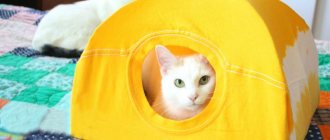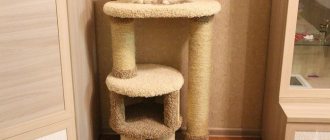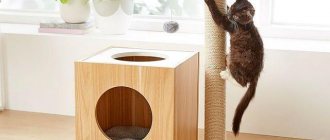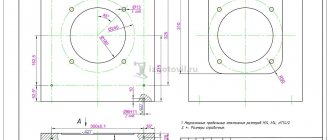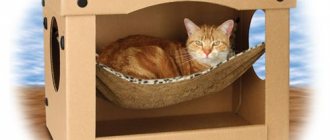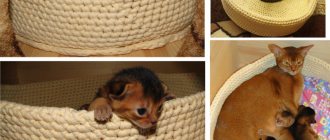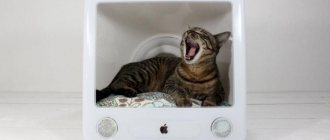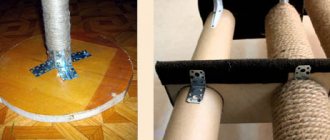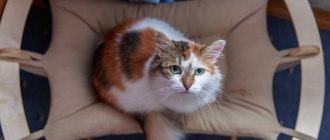In connection with the onset of winter, you should consider the question of how to help a cat who spends a lot of time outside or lives in the yard survive the frost.
Often homeless cats cannot find shelter for the night. As the days and nights get colder, animals desperately need help to survive the winter. Cold causes inflammation of the animal's respiratory tract, urinary and reproductive systems. How to help animals? You can make an outdoor winter house for a cat with your own hands or buy a ready-made one in a store. It is often not possible to provide cats with a warm home or basement that provides even a little protection from the cold. If a cat lives at your dacha or in a private house, and you don’t go there every day in winter, you can buy a winter house for your cat outside. There are many models of houses in which the animal will wait for the breadwinner to come home from work. A wonderful, warm hut will help the animal spend rainy days, cool evenings, and cold nights.
Wooden winter house for a cat – photo
Materials
To build a house on a garden or summer cottage that will please the eye and surprise guests and neighbors with its architecture, you will need high-quality building materials:
- lining (for wall cladding),
- slats (for making a frame),
- plywood (you can use it to upholster the inside of the house),
- tongue and groove boards (for flooring),
- roofing felt or ondulin (for the roof),
- metal corners (for fastening structures).
Be sure to calculate the size of the house: too big is not needed - the cat will be uncomfortable and cool in it; too cramped is also not suitable - its occupant should be able to easily turn around inside and take a comfortable position (most often they focus on the parameters 1.5 x 1.2 x 0.5 m).
Based on the intended dimensions, stock up on the required amount of material. Also provide means to protect your cat's home from fungus so that the structure will last longer. And in order for a winter house to reliably warm its owner, the walls must be insulated with some suitable material.
To build a cat house with your own hands in the courtyard of a city residential building, you can focus on the economical option. Suitable building materials:
- a large cardboard box (as an option - an old bedside table that has become unnecessary);
- duct tape;
- pieces of foam;
- thick film or a piece of an old waterproof tablecloth.
Options for winter houses for cats
Today there are many options for warm houses for cats on the market. Among them are the following types:
- insulated cat house in the form of a temporary small simplified structure;
- spacious outdoor warm cat boxes on one level, in which you can feed the animal;
- large houses of two floors, designed for simultaneous stay of several cats at once.
Typically, a pet’s housing is made of the following materials:
- lining (for external wall insulation);
- plywood (for upholstery inside);
- board (for heated floors).
Tools
In addition to the traditional hammer and saw, it would be nice to use such modern tools as staplers (for nails and staples), a pneumatic hammer - the work will go faster and bring more pleasure. You will also need good scissors.
How to make a scratching post?
In some cases, home craftsmen want to add additional elements to a simple design. Most often, a small play area is set up, containing a scratching post and hanging toys. Let's look at how to make a scratching post with a platform for a plywood house for your cat.
First you will need to prepare a tube that will serve as the barrel of the scratching post. Not only wooden products are suitable for these purposes, but also parts made of plastic. Next, the outer surface of the tube is coated with an adhesive composition. Then the part is tied with rope.
Important! The observation deck is made of plywood. It should have small dimensions (approximately 30 by 30 cm). The part is fixed to the trunk using metal corners and self-tapping screws, after which it is covered with foam rubber and carpet.
At the end, you will need to fix the scratching post with the platform on the booth. Metal corners and screws are also used for this. You can hang a toy on a rope on the lower part of the platform.
Option from boxes
An insulated outdoor house can be made from ordinary cardboard boxes. You will need two, which can be nested one inside the other like a nesting doll. There must be a small space between them. Newspapers or foam plastic are placed at the bottom of a large box; this is a good insulation. At the bottom of the smaller one (in which the animal will be located) - soft fabric, old items of clothing.
It is important that they are natural (cotton, flannel, or even better, fleece), and not synthetic, since synthetics do not keep you warm in cold weather.
Natural wool could be ideal for bedding, since it is warm, but it has one drawback - when wet (and this can happen if a cat brings snow into the house on its paws), its fibers take too long to dry.
INTERESTING TO FIND OUT: Why does a cat shed a lot?
After the structure is insulated from the inside, the doors of the small (inner) box need to be closed, and an entrance must be cut out in its lid, in the corner. A convenient size is 14x14 cm. The edges of the inlet hole should be taped with tape so that they do not fray too quickly. The lid and walls of a large box will create a kind of canopy and protect the cat’s house from the wind along with its mustachioed and striped inhabitant.
Then you need to place the box in a thick plastic bag, press it against the walls of the large box, and seal the seams with wide tape.
Also use tape to secure the “canopy”. Then you will need to find a secluded place for the house, where rain, snow and wind do not reach. Do not place the structure directly on the ground, try to place it on boards or bricks, this will add reliability to it.
You can make a cat house from an old wooden box. One of the sides will become the base, and the open part will become the entrance. This “winter apartment” is placed on a tree, tightly screwed to the trunk and branches with twine, or on the ground. However, in the latter case, it is advisable to nail “legs” to the box - 10-20 cm bars. If they are stuck into the ground, the house will confidently stand on its “legs”.
If you have any unnecessary plastic container on hand, it is quite possible to build a house in it, providing insulation from the inside, as shown in the photo.
And also take a closer look at the body of an old unnecessary computer monitor or a large wicker basket - you can also use them to make a home for a cat.
Choosing a house
When choosing a shelter for a domestic cat, most owners consider primarily aesthetic qualities, partially ignoring the needs of the pet. Outdoor cat huts are exposed to changing weather conditions and must be made of durable materials that are resistant to abrasion and scratches.
Housing may be equipped with stairs. Manufacturers offer options from:
- wood,
- plastic,
- combinations of materials.
The appearance of the houses is varied, allowing you to find a model that is suitable for your pet and pleasing to the eye. For example, some options from the varied offer:
- royal castle with towers,
- mouse,
- tent,
- wooden cottage.
Walls
A good booth is made of pine wood with polystyrene foam insulation. The design includes:
- thick boards (18-20 mm thick),
- polystyrene foam 2-3 cm thick.
Thick, warm materials of the walls and floors will provide your four-legged friend with a comfortable, warm den. Walls need to be protected from moisture, direct contact with the scorching sun and wind using impregnation.
Roof, floor
Pay attention to the roof. The roof is covered with:
- bitumen,
- sheet iron,
- other waterproof material.
An interesting option is two-story houses, the second floor does not lie directly on the ground, the floor of the upper floor is warmer.
Insulation with foam tiles
It is convenient to insulate a cardboard house with polystyrene boards. They are fastened with wide adhesive tape; it is very important to fix the parts well so that the structure does not “shake.” It is also important to design the entrance well: polystyrene foam should cover the cardboard completely (so that water does not get on it). The visor above it can be made of plexiglass or rubber.
The entire structure, as in the first option, must be tightly covered with a thick film or a piece of waterproof tablecloth. The seams must be taped in the same way.
Step-by-step algorithm for assembling a plywood house
To make a reliable house for your beloved cat, you must strictly follow the instructions. Any deviations from it can lead to negative consequences. Let's look at the entire process of assembling a cat house step by step. The first thing you need to do is cut out the parts from plywood that will form the basis of the future structure. In general, you will need 6 square parts with dimensions of 40 by 40 cm. Houses with a cubic shape are the most acceptable option.
Next, you will need to make round holes in two plywood squares. This is necessary so that the cat can freely enter the booth. The edges of the holes are processed using sandpaper. At the next stage, the square parts are connected to each other. The work is carried out in such a way that the resulting structure has a base and side walls. Metal angles and screws are used to connect the parts.
The next stage is covering the internal surfaces of the house. To do this, foam rubber is placed at the bottom of the structure, after which the material is fixed using a stapler. Carpet is laid on top of the foam rubber, which is also secured using a stapler. The side walls are sheathed using a similar technology.
Important! All work is carried out according to the drawing. Before starting assembly, it is recommended that you familiarize yourself with photographs of finished structures, as well as study a video that describes in detail all the nuances of the work.
The next step involves covering the structure with the top piece. It is also fixed using metal corners and screws. At the very end, the outer cladding of the plywood structure is performed. When organizing it, as a rule, they are guided by the design of the room in which the booth will be located. The most suitable materials for this work are: paint, wallpaper, carpet.
Interesting: Using pallets in the country
“Capital” option
Such a house can be made by someone who is used to working with tools and building materials such as wood. They start, as they should, with the project, carefully thinking through all the details - the presence of internal partitions, the location of the window, the door.
INTERESTING TO KNOW: How to get rid of the smell of cat urine on the sofa
The next step is to build a frame and fill it with some kind of insulation; polystyrene foam works very well (you can use packaging from household appliances or a computer). Then they move on to interior decoration - sheathing the walls of the structure from the inside with pieces of plywood. And after that they move on to the exterior decoration of the cat’s housing with clapboard. Do not confuse the order of these types of work - this is how you will do everything faster and better.
Then it’s time to connect the walls of the house with metal corners. The structure must be durable, since the animal will not want to move into the structure if it shakes. After this, they take the floor, a tongue-and-groove board was stored for it, and at the very end of the work, they take the roof.
If you place the finished structure at a height of 15 centimeters above the ground, the floor will freeze less, this will add comfort and warmth to the cat’s housing. The most convenient foundation is concrete cubes. They need to be covered with a layer of roofing felt, and only then the house should be placed on it.
Insulation for cat kennels
Cat houses are usually insulated with one of the following materials:
- Grooved board. It is strong, reliable, and the convenient tongue-and-groove connection leaves no gaps.
- Mineral wool. Non-toxic insulation with low thermal conductivity. However, it has one significant drawback - it absorbs moisture, so when using it it is necessary to additionally install waterproofing.
- Styrofoam. A universal material for insulating surfaces from floor to ceiling. Holds heat well and is not afraid of water.
- Expanded polystyrene. Has good insulation characteristics. It is not afraid of moisture, does not deteriorate under the influence of water, has low thermal conductivity and a high strength coefficient.
- The water-repellent film acts as waterproofing.
Useful tips and ideas
A house designed for not one, but two inhabitants should be either two-room or two-story. By the way, a building with internal partitions is much warmer than a one-room option.
Be prepared for the fact that the house needs to be cleaned from time to time. To simplify the process, you can open one of the walls like a door. Another option is a removable roof or a folding roof equipped with hinges.
The door of such a home should conveniently open from the inside and slam shut when the owner goes for a walk.
A cat in any circumstances, and especially when it finds itself in nature, begins to hunt. It is more convenient to observe the prey from a height, so a convenient observation post can be provided on the roof.
Don't try to make your cat's home too bright. Your pet will like his home more if it looks natural - just coat the boards with varnish and complete the exterior decoration.
* * *
A warm winter house for a cat is your opportunity to give a gift to your pet or help a mustachioed tabby who, by the will of fate, finds himself without a “permanent place of residence.”
The topic is actively discussed on the Internet, it also has opponents, but most of the participants in the discussion agree: if it is not yet possible to resolve the issue of placing all ownerless animals in nurseries, we need to help at least in this way - by building housing for cats and dogs. After all, they are our brothers. Smaller ones.
Features and purpose of the house
To help your cat survive the winter and create an insulated house, you need to know what characteristics the design should meet:
- heat retention and protection from precipitation. Appearance is far from the most important criterion. The main thing is that the pet is comfortable;
- insulation from the inside;
- To maintain heat and protect against snow and moisture, the booth should stand at some elevation above the ground. When using legs, they should be made stable;
- small sizes. The room should be designed for no more than 6 cats;
- small entrance, which is required to retain heat inside.
